Over the coming years we should expect to see smaller planes on longer routes. We’ve already seen many airlines retire 747s and replace them with 787s and A350s.
The introduction of the A321XLR in 2023 will be even more drastic, as it will be able to operate nonstop flights of up to 10 hours.
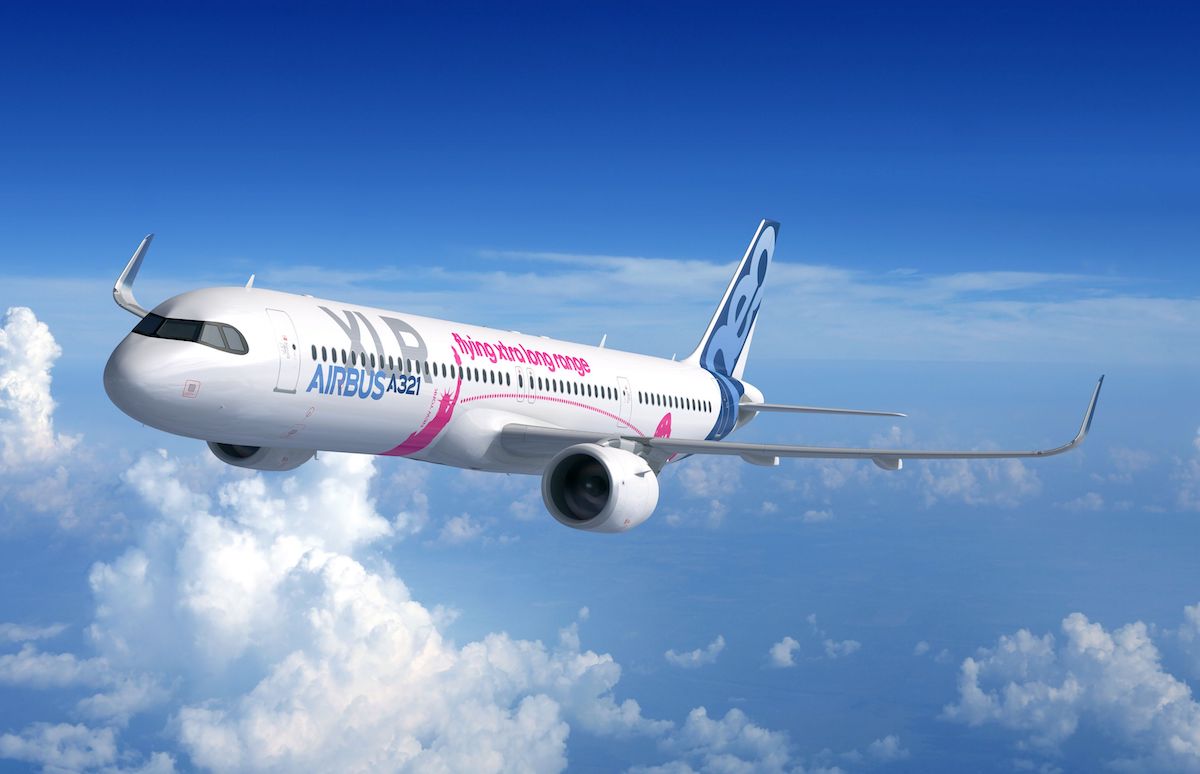 Airbus A321XLR
Airbus A321XLR
Passengers will value the convenience of nonstop flights in markets that weren’t previously financially viable, but what does this mean for the onboard experience?
In this post:
The state of narrow body flat bed business class
At this point I’d say the swankiest business class product you’ll find on a narrow body plane is JetBlue Mint, which was introduced back in 2013.
 JetBlue A321 business class
JetBlue A321 business class
This is a staggered configuration, though what makes it unique is that the “throne” seats (which are the solo seats in every other row) have doors. JetBlue was the first airline in the world to introduce doors in business class.
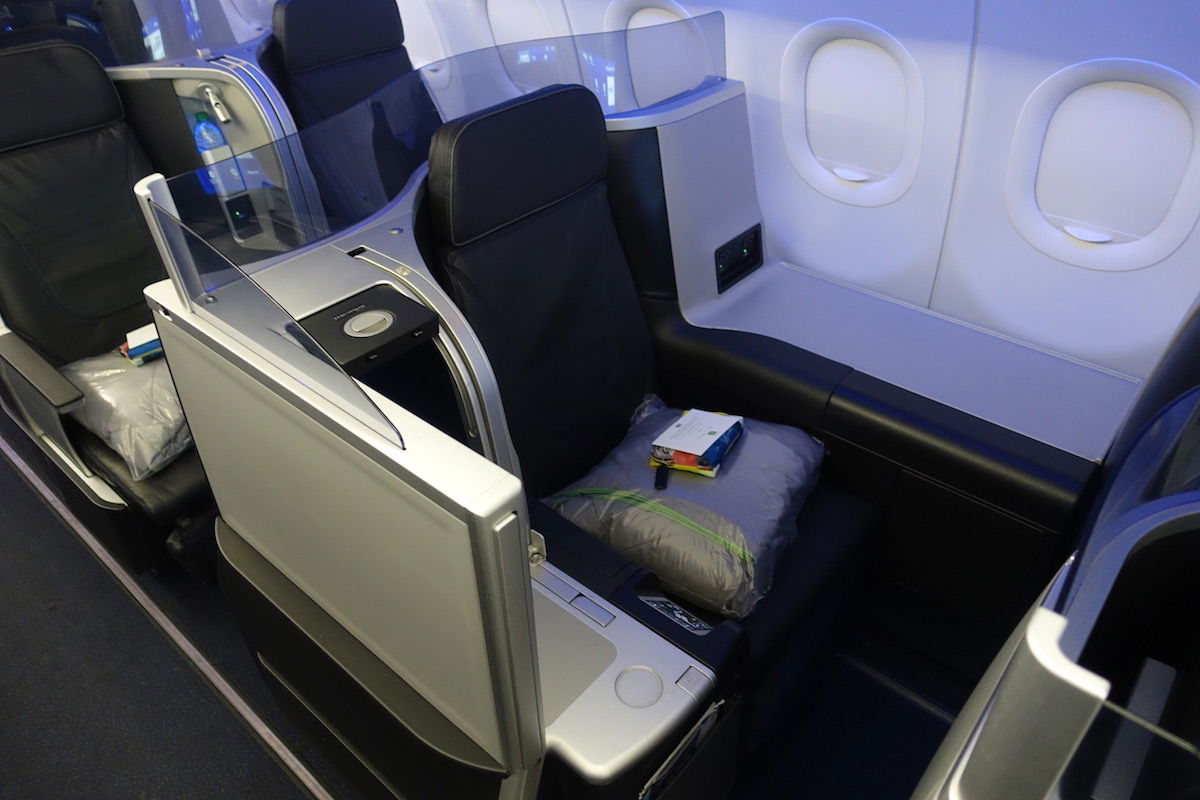
JetBlue A321 business class
Since 2013 we’ve seen several other airlines introduce flat beds in business class on narrow body aircraft, though nothing has surpassed, let alone matched, JetBlue Mint. Airlines like Aer Lingus and TAP Air Portugal are using the same staggered configuration on the A321LR, though it’s a more basic version of the seat, as there are no doors.
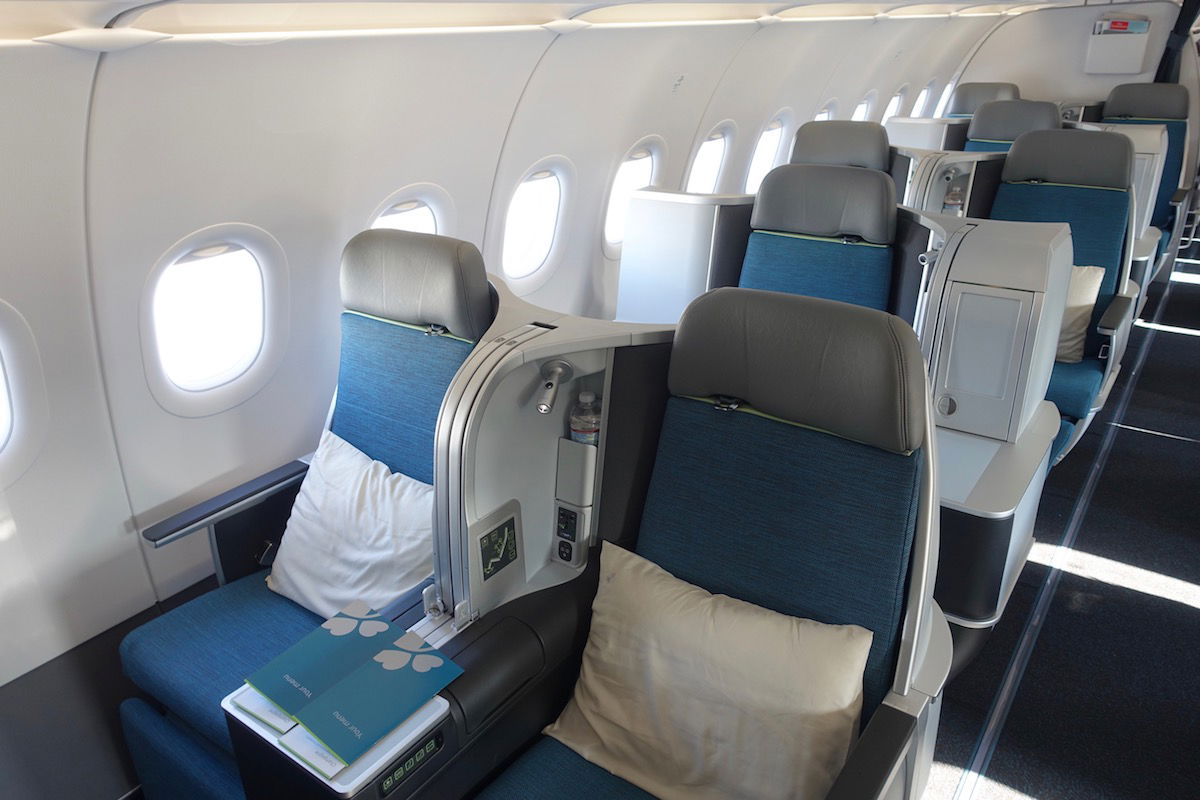 Aer Lingus A321LR business class
Aer Lingus A321LR business class
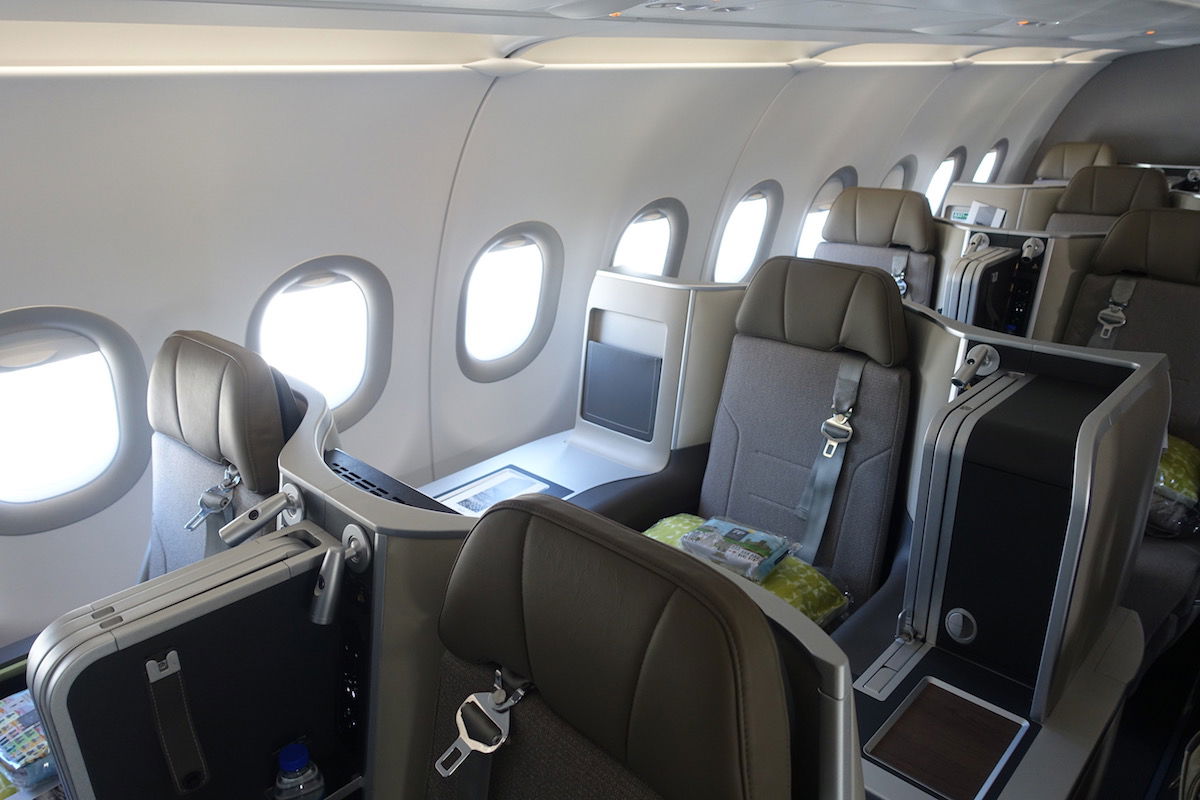
TAP Air Portugal A321LR business class
American does have some A321Ts with reverse herringbone seats, though these are marketed as first class, and not business class.
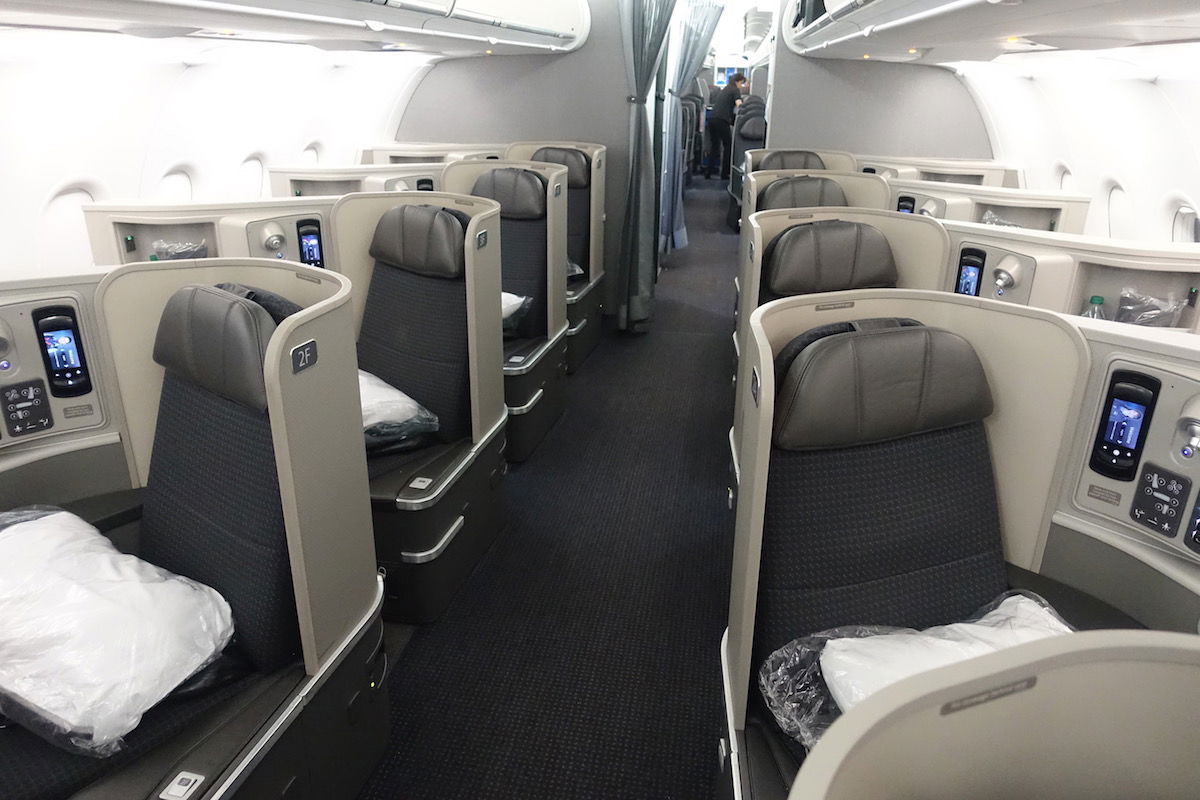 American A321T first class
American A321T first class
Direct aisle access seats are coming
With several full service airlines having ordered narrow body planes with the intention of using them for long haul flights, there’s no doubt we’ll see some improvements when it comes to business class seats.
For example:
- JetBlue plans to start flying to London in 2021 using A321LRs, and they intend to introduce a new business class with direct aisle access from every seat
- American has ordered A321XLRs, expected to be delivered starting in 2023, and they plan to offer direct aisle access from every business class seat
As I said above, airlines and seat manufacturers have had a long time to raise the bar since JetBlue Mint was introduced in 2013, though despite that, as of now there’s only a single product I know of that’s promising flat bed business class with direct aisle access on narrow bodies.
Specifically, that’s Thompson Aero’s VantageSolo seat. Thompson Aero is the same seat manufacturer that makes all of the staggered seats mentioned above (including on JetBlue, Aer Lingus, and TAP Air Portugal), so this is their evolution of the product.
Basics of Thompson’s VantageSolo seat
I’ve written about this seat in passing in the past, though some new pictures were recently released of the seats, so I wanted to look at this product in a bit more detail.
The VantageSolo seat essentially offers a herringbone configuration, as seats are in a 1-1 configuration facing the aisle.
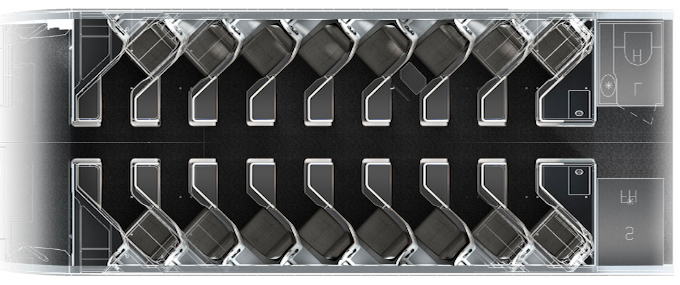
Yes, on the surface that’s a step backwards for business class. Many airlines introduced herringbone seats nearly two decades ago, and they’re now rather unpopular with passengers.
 Virgin Atlantic herringbone business class
Virgin Atlantic herringbone business class
However, by looking at renderings of these VantageSolo seats, you’ll notice that many of the downsides of traditional herringbone seats have been addressed.
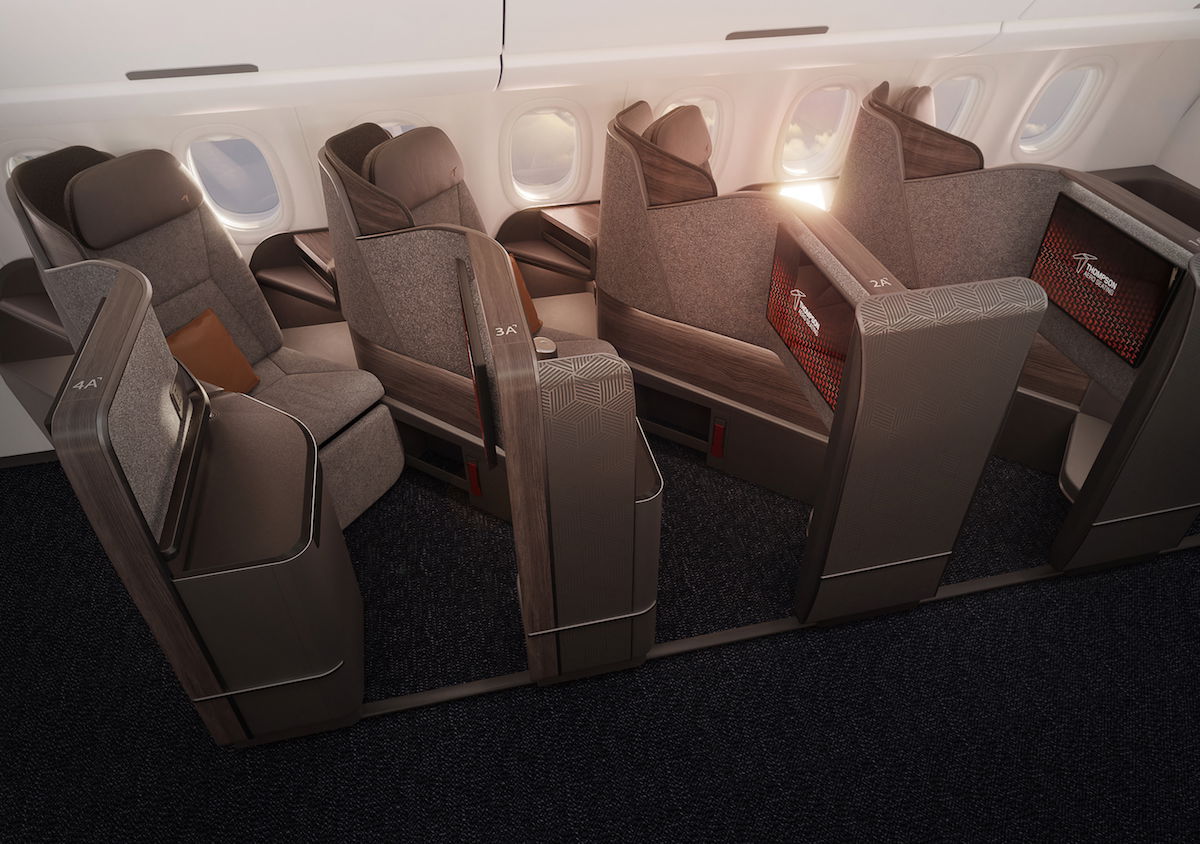 Thompson Aero VantageSolo seats
Thompson Aero VantageSolo seats
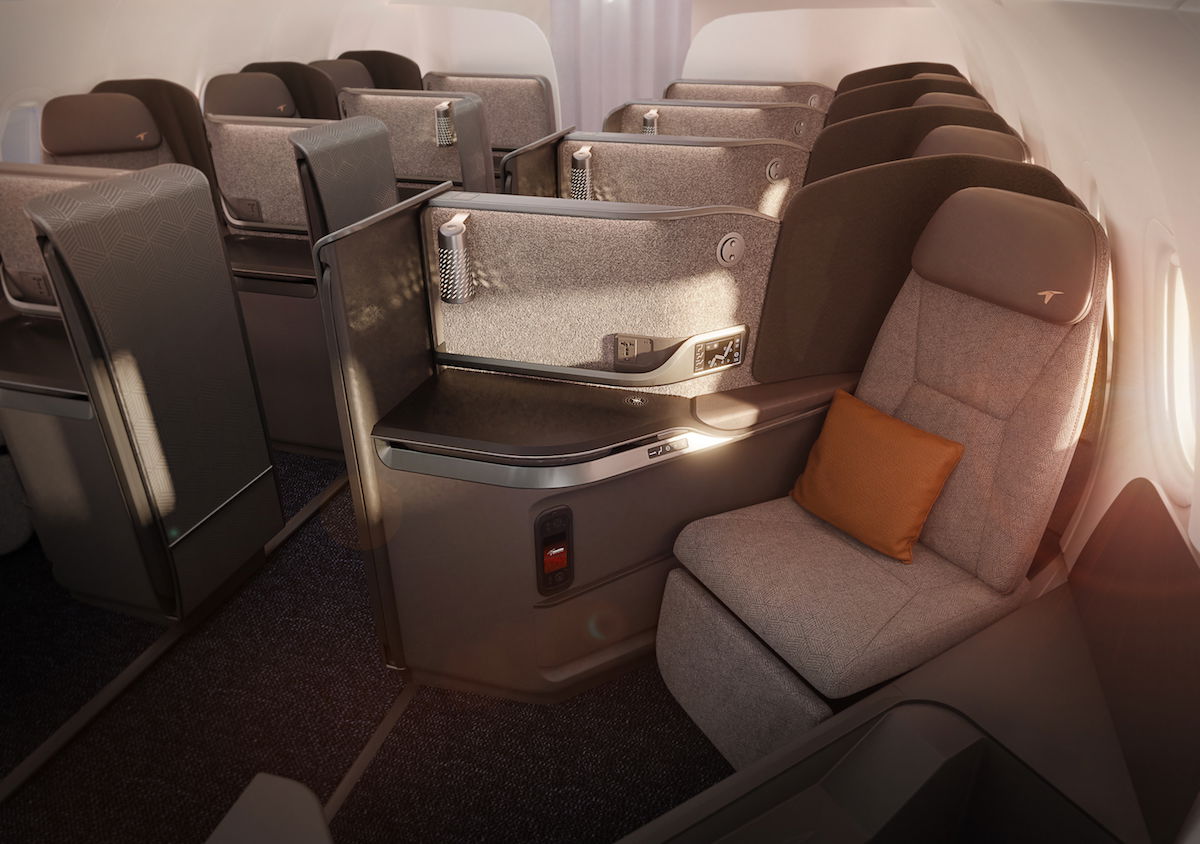
Thompson Aero VantageSolo seats
Yes, the seats face away from the windows, and that’s not ideal. Otherwise there are some considerable improvements compared to past herringbone seats, though:
- The seats have storage space, as there’s a large counter by the aisle, and another one towards the back of the seat
- The extra storage is made possible because the seats feature footwells (though rather large ones, by the look of it), rather than just offering exposed ottomans, which make the counter space possible without taking up additional space
- The seats can be reclined into bed mode, rather than having to “flip” them over
- The seats have significantly more privacy, both with a privacy shield around the back of the seat, and with additional privacy at the aisle
- It even seems like these seats could feature doors, though we’ll see if any airlines end up doing that
Lastly I think it’s worth sharing the below rendering — note the particularly spacious seat in the first row!
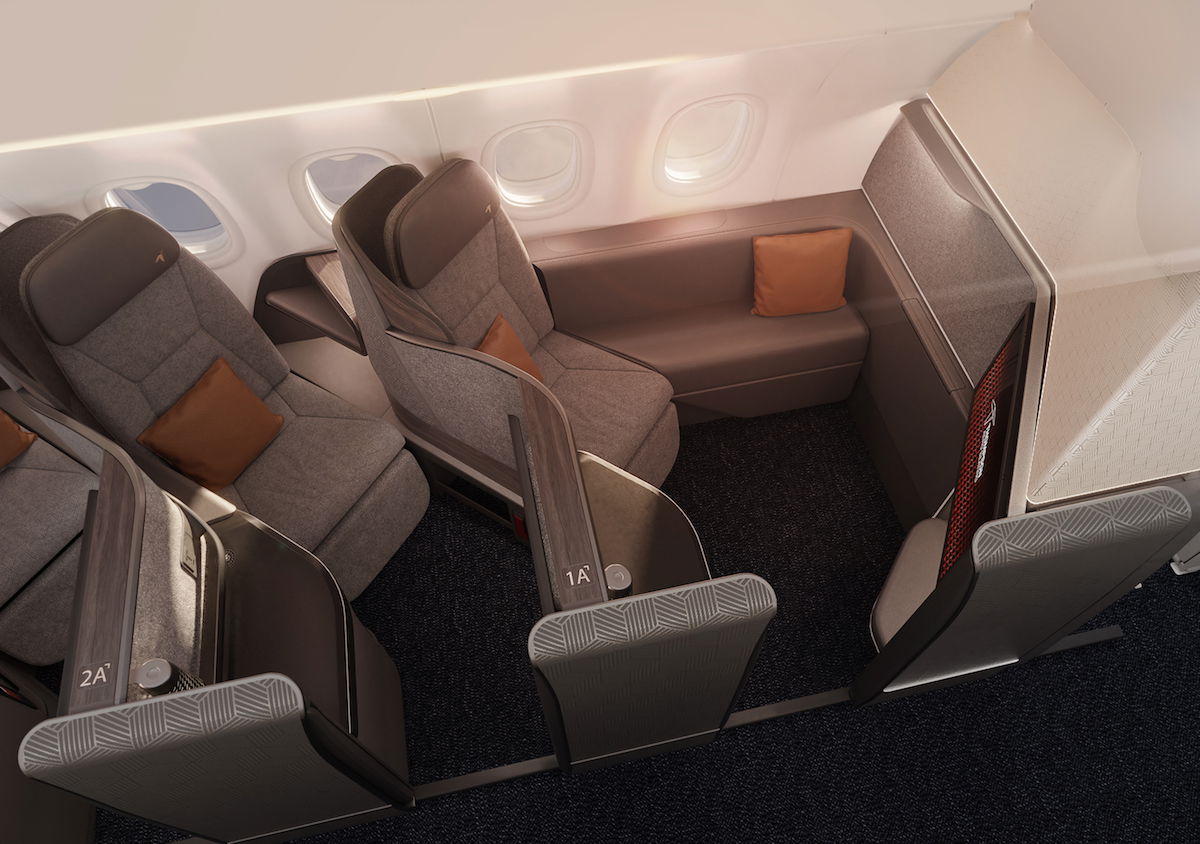
Thompson Aero VantageSolo seats
I guess we could see airlines introduce some sort of “premium” business class and charge extra to assign that seat.
More realistically, though, I doubt airlines will actually choose to have that seat. Rather than offering all that extra space to the passenger in row one, they’ll likely put a closet in the space that would otherwise be dedicated to that extra portion of the seat.
Bottom line
It seems like the VantageSolo seat is the frontrunner for fully flat direct aisle access business class on narrow body planes. Thompson is a well known and reliable seat manufacturer that has the ability to produce seats in large quantities, and that’s something airlines will value.
Ultimately I’d say I feel lukewarm towards this seat. I don’t love facing away from the windows, but I do appreciate that this at least addresses some of the other issues with herringbone seats.
While we’ve been hearing about the VantageSolo seat for a few years now, there’s always a chance that another seat manufacturer introduces a competing seat that’s even better. After all, ANA introduced their new business class with virtually no advance notice.
What do you make of the VantageSolo seat?





Don't see the point, why not use Apex Suites instead, Apex save even more space, direct aisle, also no side sitting and swing PE, still the small storage issue unsolved for Apex
if we think about how biz seats have evolved, it all make sense. and the key drive is to cram more seats in, with the cabin width as the key boundary condition.
the evolution all started with wide body (twin-isle).
in early days, the configuration was 2-2-2. fully flat ones are great for passengers, but they take too much space--in particular, huge foot space. so for airlines, that's wasteful.
angled ones, by...
if we think about how biz seats have evolved, it all make sense. and the key drive is to cram more seats in, with the cabin width as the key boundary condition.
the evolution all started with wide body (twin-isle).
in early days, the configuration was 2-2-2. fully flat ones are great for passengers, but they take too much space--in particular, huge foot space. so for airlines, that's wasteful.
angled ones, by sticking the foot space of the seat behind underneath the seat in the front, partially solve the issue. but passengers dislike them.
but that's not the only issue. These 2-2-2 seats are TOO wide, and leave wide isles. just recall the old UA 2-4-2 seats, and one would realize how wide and "wasteful" the 2-2-2 ones are.
to use the space more efficiently, many airlines go 2-3-2, and some even 2-4-2; but passengers want direct isle access.
so there comes the first important invention, the herringbone. by "tilting" the seat orientation, they can fill the cabin width more efficiently, without leaving wide isles (nor wide seats).
but one key issue is within each seat how space is used. in early herringbone seats (like Virgin Atlantic), each seat takes all the space above its footprint on the floor--which means the designer never thought about space-duplexing (assigning space in different heights to different seats, but rather dividing each seat using simple vertical walls), resulting in disadvantages such as lack of arm-space, lack of storage space, while the space above each ottoman is totally wasted. also since passengers have to enter the seat from the END of the seat (foot side), the ottomans are small, in order to leave the opening for seat entrance. not to mention the privacy issue that everyone is facing the isle.
to address some of the disadvantages, the next important invention is the reverse herringbone. the seats are now facing away the isle. but the key difference is that, now passengers are entering the seat space from the SIDE of each seat. therefore, the reverse herringbone seat are LESS "tilted" than the herringbone ones (if you think about the entrance to each seat), which means they are more "forward facing". If you think about it--most wide body planes can fit 4 "columns" of reverse herringbone seats (1-2-1), but only 3 "columns" of reverse herringbone seats (1-1-1).
of course there are evolution in reverse herringbone seats. early cirrus ones are more like the herringbone ones, with vertical walls dividing between seats, wasting the triangular volume above ottoman (and one has to flip the TV screen out). super diamond ones take the idea of space-duplexing, giving that volume to the seat in front, creating a good arm space.
then there comes ultra long-range narrow body planes. one key problem is that their cabin width is MORE than half of the wide body ones (just think about the configuration in coach). Therefore, using reverse herringbone (1-2-1 in wide body) would be inefficient: one cannot fit 1-1-1 in, but 1-1 would leave extra room wasted (just think AA 321T--it has wide isles in F, and seats are far from window), because of cabin width. But one just cannot further "tilt" reverse herringbone seats to fill the area--the seat entrance would be blocked (unless passengers climb over their seat cushion).
For the same reason Polaris seats would not be efficient on narrow body planes. if they go 2-2 (keeping direct isle access), they use exactly half of the cabin width as in wide body ones, leaving unused cabin width.
Other solutions, like staggered ones, do not offer direct isle access to each seat (though great for people traveling together).
So the designers finally come back to herringbone seats. they are more "tilted" than reverse herringbone seats, so they can better use up the cabin width. And to address the disadvantages in the old design, two key improvements are made. first, space-duplexing give each seat an enclosed ottoman (so passenger's feet are no longer exposed to the isle), while giving the neighboring seat some desk space. second, bending the dividing wall to create an seat entrance a bit from the side (rather than forcing people to climb over their ottoman).
it's interesting to think about how the seat design has evolved, as if we are reading into the minds of the seat designers.
I guess if all these make sense to you, by adding a few pictures and illustrations (like cabin floor map for different planes) you are welcome to revise and use this comment as another post (ok with me).
Why the fixation on doors? It’s a common theme through many of your posts. Sorry, even as a 150k miles pa traveler, I don’t see it as anything more than a slightly incremental tweak to an existing interior design.
@Marco Duprè the issue is that airlines will be using small planes on long routes (in case you missed the point of this article) ;)
To be fair the foot wells on these things do look wider than NZ’s ones.
I am only 5’11 and already too tall for NZ J seats. Footwell is super cramped and I’m forced to sleep with feet at a weird location. Feel bad for all those big rugby dudes who are 6’4!
Staggered vantageXL should also work.. with 1-1 configuration.. all aisle access too but with alternating window/aisle seats
Qatar have flat-bed seats on their A320 which are used for flights to Europe. Seats are great for sleeping or relaxing. Only downside is if you try to work on your laptop that you are limited with the width of the space for your arms.
no window views and they are too narrow... i don't understand the obsession for hyper-seclused seats on medium/short flights. it's like flying inside a coffin.
With no enthusiasm whatever, I'm travelling in Air New Zealand's old version of these ridiculous seats from AKL-EZE shortly. Not looking forward to it one little bit. The whole concept of these seats should be junked, not 'enhanced'.
What'll make or break the seat is how tight the airlines choose to configure them.
Remember how people slammed Cathay Pacific's herringbone seat so much, that they put their back into it to bring out their original (deeply-customized and later licensed to AA) Cirrus in like just 3 years? So this is totally going backwards.
This - like the airline shift to downgauge overall - is a profiteering, penny-pinching bean counter move on the airlines'...
What'll make or break the seat is how tight the airlines choose to configure them.
Remember how people slammed Cathay Pacific's herringbone seat so much, that they put their back into it to bring out their original (deeply-customized and later licensed to AA) Cirrus in like just 3 years? So this is totally going backwards.
This - like the airline shift to downgauge overall - is a profiteering, penny-pinching bean counter move on the airlines' part. I don't care what excuse they always give about scheduling or seasonality. More peoeple than ever are flying worldwide, so those are very poor, almost insulting excuses that don't jibe with the big picture of air transportation, at all.
Airlines are getting so greedy they're no longer willing to fork out for twin-aisles even when it's absolutely warranted for pax demand year-round. The 787 isn't selling because some of them wouldn't even pay for the 787, and wanted Boeing to give them its most advanced tech ever (NMA) at significantly cheaper than 787 prices. None of this looks right, it's all very fishy.
So given my opinion, I'm going to bet airlines will configure this seat way tighter than they should. Like, no wider than Virgin's dream suite, probably narrower. A short, narrow, stunted seat, but hey it looks good on paper and tick all the boxes in theory. You can thank me later ;)
i could see B6 springing for this. this seat would be a convenient option for them given that they’ve already done a lot of work with thompson for their original Mint seat. consolidation of maintenance would be reasonably easy and i’m guessing their relationship with TAero is good. would love to see B6 spring for including that front seat - i for one wouldn’t mind spending a little extra for a spacious seat (that kind...
i could see B6 springing for this. this seat would be a convenient option for them given that they’ve already done a lot of work with thompson for their original Mint seat. consolidation of maintenance would be reasonably easy and i’m guessing their relationship with TAero is good. would love to see B6 spring for including that front seat - i for one wouldn’t mind spending a little extra for a spacious seat (that kind of premium would fit well over the current throne/no throne combo.). i wouldn’t be surprised if this public release of the seat is after work with B6 to customise the seat to their liking given they’ve already announced intention to introduce a new direct access J product for next year. would also be exciting to see this introduced onto QF + VA narrowbodies for domestic and trans-tasman operations. would certainly soften the blow from the occasional wide body downgrade to narrowbodies lol.
Could a scaled down version of the Apex Suite work? I guess narrower, less storage and possibly enclosed foot wells but something like the Apex Suite could work although it wouldn't be anywhere as dense as the Vantage Solo
While I’m also not a fan of facing the aisle, it still seems like a very solid seat. Keep in mind that on the reverse herringbone, which would be generally considered better, the windows are very far away from the seats. I experienced that issue on American’s A321T first class. If anything this new seat is closer to the window with better views. I could definitely see the seats having doors-if jetBlue was to select...
While I’m also not a fan of facing the aisle, it still seems like a very solid seat. Keep in mind that on the reverse herringbone, which would be generally considered better, the windows are very far away from the seats. I experienced that issue on American’s A321T first class. If anything this new seat is closer to the window with better views. I could definitely see the seats having doors-if jetBlue was to select this for their new Mint seat for their new transatlantic flights, I’d say that’s pretty much a given. As for the seats in row 1-they look like heaven on earth. Kind of like a mini Etihad residence. It can’t hurt to have options so while it may not be my first choice, it’s certainly better than many of the lieflat seats on narrowbodys such as the B/E Aerospace Diamond seat. I’d happily take this seat over that one!
It looks to me like one of the pictures above does already have doors (just with them fully open).
I do appreciate that it is open nicely on the window side, so it should be pretty easy to look out the window, especially since your head it pretty close to the window. In some ways it would be harder if the seat faced the window, as you would be further away (and thus it would be harder to look towards the ground).
Why not have seats like this face the windows (make them reverse hb instead of hb)? That seems like the only downside of the above seat.
many might not realize but UA's polaris seat design is also capable of making staggered 2-2 all-aisle access for narrowbodies, when they choose to announce the seat replacement for premium transcon planes that are supposed to be 737-MAX 10 (yes, queue the MAX jokes)
I wonder if they’ll make room for a 2-2 PE configuration on these planes as well?
That said, I do think JetBlue’s Mint configuration is pretty nice. Even traveling solo in one of the paired seats isn’t bad, This might be denser?
Not a bad seat, the VantageSolo, at least how it looks in the renderings. I do not like the main shelf being directly next to the aisle as it's too easy for passersby to grab someone's belongings when they step out. If you think that nonsense doesn't happen in business class, think again. Some idiot actually stole my amenity kit when I was away from my seat.
It looks like it'll be even worse to side sleep on this seat compared to regular herringbone seats.
US airlines beginning to suspend flights to China btw
I can tell you for a fact that at least one airline that you may or may not have mentioned in your article is considering this exact set up, marketing and selling the first row for a premium. The plan included some additional really cool features like a 2nd table in front of the little bench to make it into a (cramped) office space. Apparently the rationale for herringbone as opposed to reverse herringbone on those narrow bodies is that it allows to fit more seats.
This looks like a huge upgrade over Virgin Atlantic or, worse, air New Zealand's J classes.
I for one like sleeping with my head near the window though- I find it a bit quieter and more private overall.